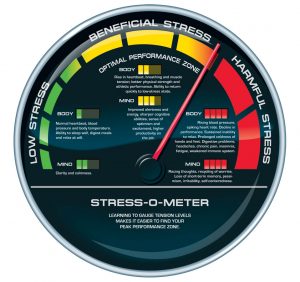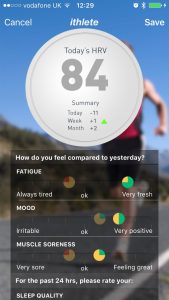After they first get ithlete, a lot of people enjoy recording their heart rate variability (HRV) every day. Watching the number fall after hard training, followed by a rebound 1-2 days later can be very satisfying. They also soon notice the impact of a late night for example, or a short illness. But it’s not always that simple to interpret the cause of changes. With HRV, like many things, the more you put in, the more you get out. By using the ithlete subjective sliders and adding comments as well as recording training loads you can add important context to your data.
Which metrics to record
For the past two years, we have provided six of the most common subjective scales used in training monitoring:
- Sleep quality
- Fatigue
- Mood
- Muscle soreness
- Stress
- Diet
Each of these areas has a significant impact on recovery and HRV.
Recording Training Load
You can record training load in many ways, ithlete leaves that up to you. Importing directly from Garmin Connect or Fitbit make for the most accurate data or if you are not using an objective load measure we suggest RPE (rating of perceived exertion) scale which is popular in professional team sports.
Total Load
One of the many things we learned whilst working with the University of Edinburgh analyzing the data of hundreds of ithlete users, is that HRV responds to total load and not just training. Total load considers all stress rather than just physical load. Examples include sleep, diet, and emotional stress.
The concept of total load is an important one and covered in detail here.
A good way to think about this is using the material science model of Stress and Strain: as you apply stress (i.e. force or pressure) to any material, it deforms, showing signs of strain. For small amounts of stress, the material returns to its starting state once the stress is removed, but when the stress increases, the deformation becomes permanent, and eventually it breaks. The human body is really no different, except that it has the ability to repair itself once the stress is removed, and become even stronger than before, unless the stress is too great for too long, when it also breaks! Young people are able to tolerate stress for longer before they break. They are more resilient, and this is reflected in their higher HRV baseline.

Image courtesy of http://fortcollinsbiofeedback.com
App updates
We have been working on making the subjective sliders and added context more intuitive and here are the changes you need to know about:
Thinking more about your recovery
The stress and strain idea above led to us separating the metrics you record into two groups:
- The ‘stress’ group of external factors
- Diet
- Mental / emotional stress
- Sleep quality (or frequently lack of!)
- Training load
- The ‘strain’ group of how your body is responding
- Fatigue
- Muscle soreness
- Mood
- HRV
- Resting HR
 We have also asked you to think about these in relation to certain time windows. For stress factors it is important to consider how you felt in the past 24 hours. This will be the period which influenced your current recovery status and the ones you’re accurately able to rate before the day gets going. These are also the factors that support your recovery if you get them right, ie great sleep, nutrition and a lack of mental / emotional stress.
We have also asked you to think about these in relation to certain time windows. For stress factors it is important to consider how you felt in the past 24 hours. This will be the period which influenced your current recovery status and the ones you’re accurately able to rate before the day gets going. These are also the factors that support your recovery if you get them right, ie great sleep, nutrition and a lack of mental / emotional stress.
Strain factors relate to how you are feeling right now. Have you woken feeling tired? Is your mood good this morning? How sore are those muscles?
Remember if a few hours after taking your measurement (or after walking down the stairs!) you want to come back and adjust your morning assessment that’s fine – and in fact encouraged, the more accurate this content the fuller your recovery picture.
Use the full range
We have noticed that when recording subjectives, people tend to use only a narrow range of the available scores, for example only 1 or 2 points around the middle value. However subjective scores become much more useful if a bigger range is used.
How do you feel in relation to yesterday?
A useful approach is to think about the value recorded today compared to that of the last reading. For this reason, the ithlete sliders now have the last reading value displayed in the background, to make it easier to think relatively i.e. am I feeling more or less tired than yesterday, and by how much?
These improvements are being rolled out first on iOS this week and will follow and shortly on Andoid!
We hope you find them useful to record the all important context and that they will help you look at total load and how your body responds over time, both objectively using HRV, HR and subjectively with how you feel.

Thats great news though I struggle with ‘yeh everythings great’ or ‘ really bad ‘..im usually just ‘meh’,unless of course I get a high HRV score or my maf pace has increased 20sec a mile from last weeks run,so scoring after a run will work well for me..
PLEASE vote to have raw data form ithlete professional downloadable next to the data form main ithlete dashboard. I it would be so useful to track over time both recovery and effort
It would only take a couple of hours from your professionals and be enormusly useful.
best
Diana
Hi Diana
Thanks for the message. We are working through the large backlog of features to be put in to ithlete Pro & Team. One of the enablers is a separate z-score processor & that is being worked on now.
kind regards,
what does ”temp medication” mean?
Temporary medication
Or
Temperature medication
Temporary medication
What does temp medication mean?
Temporary or temperature medication?
Hi Kristoffer,
Apologies for the confusion, it is referring to temporary medication.
Best, Laura